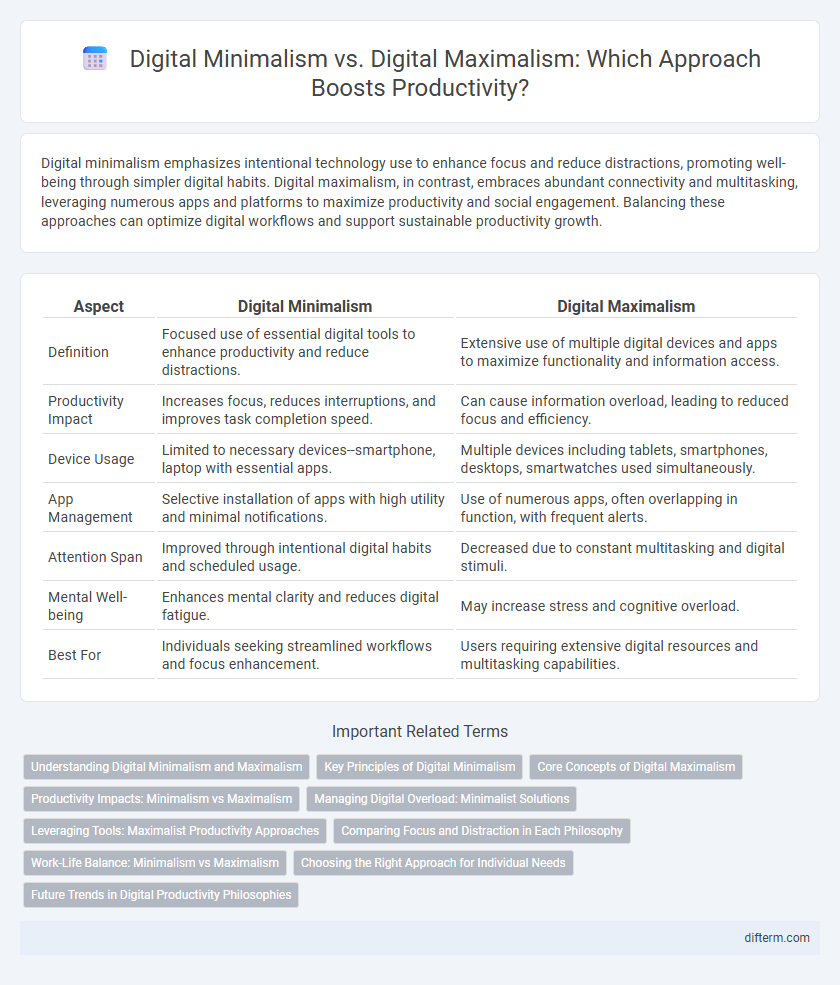Digital minimalism emphasizes intentional technology use to enhance focus and reduce distractions, promoting well-being through simpler digital habits. Digital maximalism, in contrast, embraces abundant connectivity and multitasking, leveraging numerous apps and platforms to maximize productivity and social engagement. Balancing these approaches can optimize digital workflows and support sustainable productivity growth.
Table of Comparison
| Aspect | Digital Minimalism | Digital Maximalism |
|---|---|---|
| Definition | Focused use of essential digital tools to enhance productivity and reduce distractions. | Extensive use of multiple digital devices and apps to maximize functionality and information access. |
| Productivity Impact | Increases focus, reduces interruptions, and improves task completion speed. | Can cause information overload, leading to reduced focus and efficiency. |
| Device Usage | Limited to necessary devices--smartphone, laptop with essential apps. | Multiple devices including tablets, smartphones, desktops, smartwatches used simultaneously. |
| App Management | Selective installation of apps with high utility and minimal notifications. | Use of numerous apps, often overlapping in function, with frequent alerts. |
| Attention Span | Improved through intentional digital habits and scheduled usage. | Decreased due to constant multitasking and digital stimuli. |
| Mental Well-being | Enhances mental clarity and reduces digital fatigue. | May increase stress and cognitive overload. |
| Best For | Individuals seeking streamlined workflows and focus enhancement. | Users requiring extensive digital resources and multitasking capabilities. |
Understanding Digital Minimalism and Maximalism
Digital minimalism emphasizes intentional technology use to boost focus and reduce distractions by limiting digital interactions to essential tools. Digital maximalism embraces the integration of numerous digital platforms and apps to maximize connectivity and productivity, often leading to multitasking and information overload. Understanding these approaches helps individuals tailor their digital habits for optimal efficiency and well-being.
Key Principles of Digital Minimalism
Digital minimalism centers on intentional technology use, prioritizing tools that enhance productivity while eliminating distractions and digital clutter. Key principles include setting clear boundaries for device usage, embracing solitude to foster deep work, and focusing on high-quality digital interactions that align with personal values. This approach reduces cognitive overload and promotes sustained concentration for improved efficiency.
Core Concepts of Digital Maximalism
Digital maximalism emphasizes the extensive integration of technology into daily life to maximize productivity, leveraging multiple digital tools and platforms for seamless multitasking and real-time collaboration. This approach relies on continuous connectivity, data-driven decision-making, and automation, enabling users to optimize workflows and enhance creative output. Key components include embracing advanced software ecosystems, prioritizing synchronization across devices, and fostering digital environments that support innovation and rapid information exchange.
Productivity Impacts: Minimalism vs Maximalism
Digital minimalism enhances productivity by reducing distractions and fostering deep focus through intentional technology use, leading to improved task efficiency and mental clarity. Digital maximalism often results in information overload, fragmented attention, and decreased work performance due to multitasking and constant digital interruptions. Choosing minimalism supports sustained concentration and effective time management, while maximalism can hinder productivity by overwhelming cognitive resources.
Managing Digital Overload: Minimalist Solutions
Digital minimalism emphasizes intentional use of technology by limiting notifications, decluttering apps, and setting strict usage boundaries to enhance focus and reduce cognitive overload. This approach boosts productivity through streamlined digital environments that prevent distractions and promote meaningful interactions. Managing digital overload with minimalist solutions fosters sustained attention, mental clarity, and efficient task completion.
Leveraging Tools: Maximalist Productivity Approaches
Digital maximalism in productivity emphasizes leveraging a wide range of tools and applications to create integrated workflows that boost efficiency and multitasking capabilities. By using comprehensive platforms like Notion, Zapier, and Trello together, maximalists automate repetitive tasks and centralize information, enhancing organizational clarity and time management. This approach exploits technology's full potential, enabling users to handle complex projects and dynamic schedules with increased adaptability and control.
Comparing Focus and Distraction in Each Philosophy
Digital minimalism promotes deep focus by limiting digital interactions and reducing exposure to distractions like social media and constant notifications. In contrast, digital maximalism embraces multiple digital tools and platforms, often leading to fragmented attention and increased susceptibility to interruptions. The minimalist approach fosters sustained concentration and productivity, whereas maximalism can result in frequent task-switching and reduced cognitive performance.
Work-Life Balance: Minimalism vs Maximalism
Digital minimalism promotes a balanced work-life dynamic by encouraging focused technology use, reducing multitasking and digital distractions to enhance productivity and mental clarity. In contrast, digital maximalism embraces constant connectivity and diverse digital tools, often leading to blurred boundaries between professional and personal time, which can increase stress and reduce overall well-being. Prioritizing digital minimalism supports clearer separation of work and personal life, fostering sustained productivity and improved mental health.
Choosing the Right Approach for Individual Needs
Digital minimalism emphasizes reducing digital distractions by limiting app usage and social media time, enhancing focus and deep work effectiveness. In contrast, digital maximalism leverages a wide array of tools and platforms to boost creativity and connectivity, suitable for multitasking and dynamic workflows. Selecting the right approach depends on individual productivity goals, cognitive capacity, and work environment, ensuring technologies serve as facilitators rather than sources of stress.
Future Trends in Digital Productivity Philosophies
Digital minimalism emphasizes focused technology use to enhance productivity by reducing distractions and cognitive overload, aligning with future trends prioritizing mental well-being and efficiency. Digital maximalism embraces integrated, multi-platform workflows leveraging AI and automation to amplify output through constant connectivity and data-driven insights. Emerging productivity philosophies will likely blend minimalist principles with maximalist technologies, fostering balanced, adaptive digital environments optimized for both deep work and responsive collaboration.
Digital minimalism vs Digital maximalism Infographic

 difterm.com
difterm.com